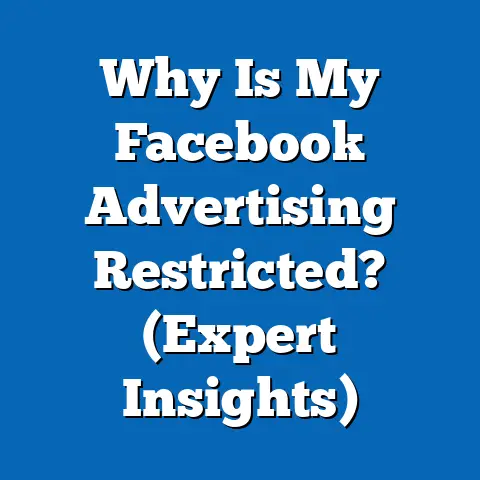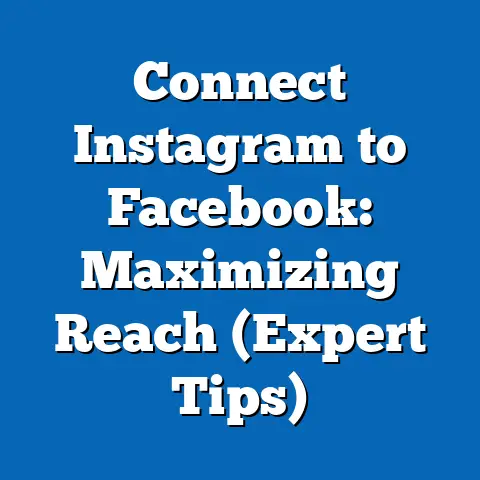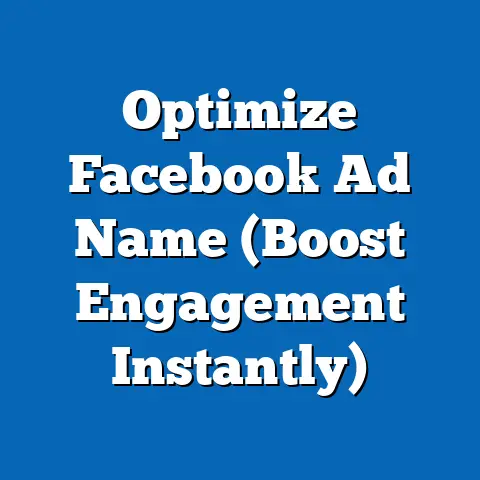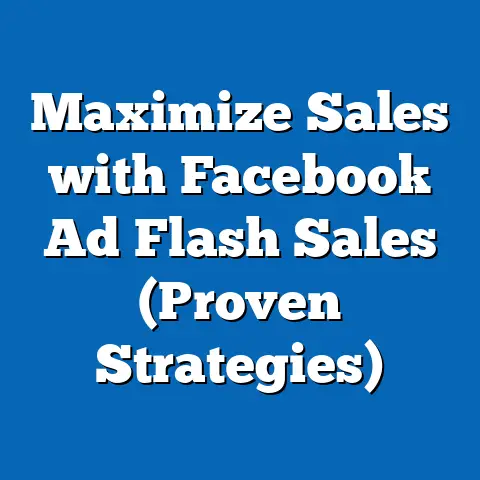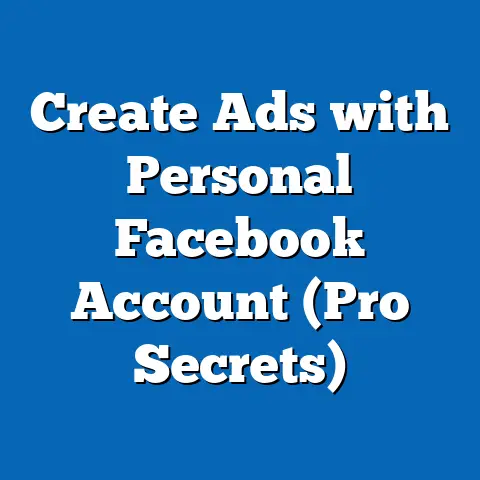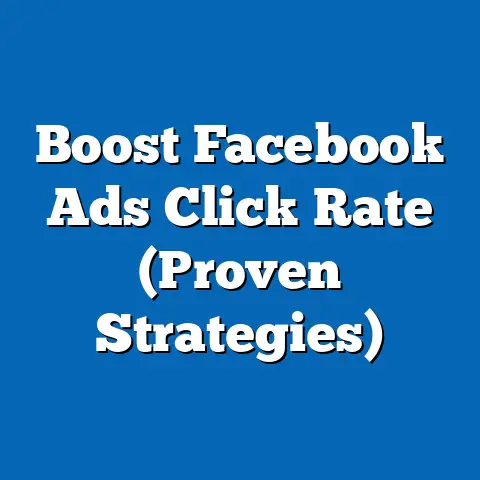Optimize Facebook Video Ad Length (Expert Strategies)
Imagine a digital arena, a coliseum of flashing screens and fleeting attention spans. Brands enter as gladiators, each armed with a video ad, vying for the precious gaze of the modern consumer. But unlike ancient Rome, the battle isn’t won with brute force, but with precision, relevance, and… brevity.
In the world of Facebook advertising, you’re not just competing with other ads; you’re competing with cat videos, political rants, and baby pictures. You have mere seconds to capture attention, convey your message, and compel action. A poorly optimized video ad is like a gladiator entering the arena with a dull sword – destined for defeat.
I’ve seen countless brands pour significant resources into Facebook video ads, only to be met with dismal results. Why? Often, it boils down to one critical factor: video length. Too long, and viewers tune out. Too short, and your message gets lost. It’s a delicate balance, a high-wire act of engagement.
Section 1: Understanding the Psychology of Video Consumption
Before diving into the technical aspects of video length, it’s crucial to understand the underlying psychology of video consumption. Why do people watch (or not watch) video ads? What motivates them to engage? How can you tap into these psychological drivers to create more effective ads?
The All-Important First Few Seconds
Think of your video ad as a first impression. You only get one chance to make it count. Studies consistently show that the vast majority of viewers decide whether to continue watching a video within the first three seconds. If you haven’t hooked them by then, you’ve likely lost them forever.
I remember one client who ran a beautiful, high-production-value video ad. The problem? It started with a slow, meandering intro that took almost ten seconds to get to the point. Unsurprisingly, their view rates were abysmal. We reworked the ad to start with a compelling visual and a direct statement of value, and their view rates skyrocketed.
Takeaway: Your opening seconds are gold. Make them visually arresting, intriguing, and relevant to your target audience.
The Retention Cliff: Why Viewers Drop Off
Even if you manage to hook viewers initially, keeping them engaged throughout the entire video is a challenge. Research shows that viewer retention rates plummet after the first 10 seconds. This “retention cliff” is a stark reminder that every second counts.
Why does this happen? Several factors contribute:
- Information Overload: We live in an age of constant stimulation. Viewers are bombarded with content from all directions, making it difficult to hold their attention for extended periods.
- Lack of Relevance: If the video doesn’t immediately demonstrate value or relevance to the viewer, they’ll quickly lose interest.
- Poor Pacing: A video that’s too slow, repetitive, or confusing will quickly bore viewers.
Takeaway: Keep your video concise, focused, and engaging from start to finish. Cut out any unnecessary fluff or distractions.
Emotional Triggers: Connecting with Your Audience
While brevity is important, it’s not the only factor. The most effective video ads tap into viewers’ emotions, creating a connection that transcends mere information.
Think about the most memorable ads you’ve seen. What made them stand out? Chances are, they evoked some kind of emotional response – humor, sadness, inspiration, or excitement.
I once worked on a campaign for a local animal shelter. Instead of focusing on statistics about animal neglect, we created a series of short videos featuring heartwarming stories of rescued animals finding loving homes. These videos resonated deeply with viewers, driving a significant increase in donations and adoptions.
Takeaway: Identify the emotional triggers that resonate with your target audience and weave them into your video ad.
Trends in Video Consumption on Facebook
Understanding how people consume video on Facebook is essential for optimizing your ad length. Here are a few key trends to keep in mind:
- Mobile-First: The vast majority of Facebook users access the platform on their mobile devices. This means your video ads need to be optimized for small screens and short attention spans.
- Sound-Off Viewing: Many Facebook users watch videos with the sound off, especially in public places. This means your video ads need to be visually engaging and easily understandable without audio.
- Short-Form Dominance: Short-form video content, such as Reels and Stories, is increasingly popular on Facebook. This trend is influencing viewer expectations and preferences, making shorter video ads more effective.
Takeaway: Design your video ads with the mobile, sound-off, and short-form viewing experience in mind.
Section 2: The Ideal Length for Facebook Video Ads
Now that we’ve explored the psychology of video consumption, let’s get down to brass tacks: What is the ideal length for Facebook video ads? The answer, as with most things in marketing, is “it depends.” But don’t worry, I’m not going to leave you hanging.
Industry Standards and Best Practices
While there’s no one-size-fits-all answer, several industry standards and best practices can guide your decision-making:
- Brand Awareness Ads: For brand awareness campaigns, aim for video ads between 15 and 30 seconds. This allows you to tell a concise story, showcase your brand’s personality, and leave a lasting impression.
- Consideration Ads: For consideration ads (e.g., driving traffic to your website or app), aim for video ads between 15 and 60 seconds. This gives you more time to explain your product or service, highlight its benefits, and encourage viewers to take action.
- Conversion Ads: For conversion ads (e.g., driving sales or leads), aim for video ads between 15 and 30 seconds. This requires a laser-focused message, a clear call to action, and a sense of urgency.
Takeaway: Use these guidelines as a starting point, but remember to tailor your video length to your specific campaign objectives and target audience.
Short-Form vs. Long-Form: Which is Right for You?
The debate between short-form and long-form video ads is ongoing. Both formats have their advantages and disadvantages:
- Short-Form (Under 15 Seconds):
- Pros: Captures attention quickly, ideal for mobile viewing, aligns with short attention spans, cost-effective.
- Cons: Limited storytelling potential, may not be suitable for complex products or services, requires a highly focused message.
- Long-Form (Up to 60 Seconds):
- Pros: Allows for more in-depth storytelling, suitable for explaining complex products or services, can build stronger brand connections.
- Cons: Requires higher production quality, may lose viewers’ attention, can be more expensive.
- Pros: Captures attention quickly, ideal for mobile viewing, aligns with short attention spans, cost-effective.
- Cons: Limited storytelling potential, may not be suitable for complex products or services, requires a highly focused message.
- Pros: Allows for more in-depth storytelling, suitable for explaining complex products or services, can build stronger brand connections.
- Cons: Requires higher production quality, may lose viewers’ attention, can be more expensive.
I’ve found that short-form video ads are particularly effective for retargeting campaigns. These viewers are already familiar with your brand, so you don’t need to spend as much time explaining who you are or what you do. A concise, compelling message with a clear call to action can be highly effective.
Takeaway: Consider your target audience’s familiarity with your brand and the complexity of your product or service when deciding between short-form and long-form video ads.
Aligning Length with Campaign Objectives
The most important factor in determining your video ad length is your campaign objective. What do you want viewers to do after watching your ad?
- If your goal is to drive brand awareness, focus on creating a visually appealing and memorable video that showcases your brand’s personality and values. The length should be sufficient to convey your message effectively, but not so long that viewers lose interest.
- If your goal is to drive traffic to your website, focus on highlighting the benefits of visiting your site and providing a clear call to action. The length should be sufficient to pique viewers’ interest and motivate them to click through.
- If your goal is to drive sales, focus on showcasing the value of your product or service and creating a sense of urgency. The length should be sufficient to address viewers’ pain points and convince them to make a purchase.
Takeaway: Clearly define your campaign objectives before creating your video ad and tailor the length to maximize your chances of achieving those objectives.
Case Studies: Learning from the Pros
Let’s take a look at a few examples of successful Facebook video ad campaigns that have effectively utilized different video lengths:
- Dollar Shave Club: This brand is known for its humorous and irreverent video ads. Their original video ad, which was almost 90 seconds long, went viral and helped them build a massive following. While this ad was longer than the recommended length for Facebook, it was so engaging and memorable that viewers were willing to watch it all the way through.
- Airbnb: This brand often uses short, visually stunning video ads to showcase unique travel experiences. Their ads are typically under 15 seconds, but they effectively capture the essence of their brand and inspire viewers to book a trip.
- Nike: This brand is known for its inspiring and motivational video ads. Their ads often feature athletes overcoming challenges and achieving their goals. While some of their ads are longer, they are always visually compelling and emotionally resonant.
Takeaway: Study successful video ad campaigns in your industry to get inspiration and learn what works.
Section 3: Crafting Compelling Content for Every Second
Once you’ve determined the ideal length for your Facebook video ad, the next step is to create compelling content that maximizes impact within that timeframe. Every second counts, so you need to make sure that every element of your video is working hard to engage viewers and drive results.
Hooking Viewers in the First 3 Seconds
As I mentioned earlier, the first three seconds of your video ad are crucial. This is your chance to grab viewers’ attention and convince them to keep watching. Here are a few tips for creating a compelling hook:
- Use a visually arresting image or video clip: Start with something that will immediately catch viewers’ eyes. This could be a stunning landscape, a close-up of your product, or a humorous scene.
- Ask a question: Pose a question that is relevant to your target audience’s pain points or interests.
- Make a bold statement: Start with a statement that is surprising, controversial, or thought-provoking.
- Showcase a problem: Highlight a problem that your target audience is facing and hint at a solution.
I once created a video ad for a local gym that started with a close-up of someone struggling to lift a weight. The voiceover asked, “Tired of feeling weak and out of shape?” This immediately grabbed the attention of viewers who were struggling with their fitness goals.
Takeaway: Experiment with different hooks to see what resonates best with your target audience.
Clear Messaging: Getting to the Point
In a short video ad, you don’t have time to beat around the bush. You need to get to the point quickly and clearly. Here are a few tips for crafting a clear message:
- Focus on one key message: Don’t try to cram too much information into your video. Focus on one key message that you want viewers to remember.
- Use simple language: Avoid jargon or technical terms that your target audience may not understand.
- Highlight the benefits, not just the features: Focus on how your product or service will benefit viewers, not just its features.
- Repeat your message: Repeat your key message several times throughout the video to ensure that it sticks with viewers.
Takeaway: Keep your message concise, clear, and focused on the benefits for your target audience.
Visual Elements: Making Your Video Pop
Visual elements play a crucial role in engaging viewers and conveying your message. Here are a few tips for using visual elements effectively:
- Use high-quality footage: Invest in high-quality footage that is visually appealing and relevant to your message.
- Use dynamic visuals: Incorporate dynamic visuals such as animations, motion graphics, and transitions to keep viewers engaged.
- Use text overlays: Use text overlays to highlight key points, reinforce your message, and provide context for viewers who are watching with the sound off.
- Use branding elements: Incorporate your brand’s logo, colors, and fonts to reinforce your brand identity.
I’ve found that adding subtitles to video ads is particularly effective for engaging viewers who are watching with the sound off. This allows them to understand your message even if they can’t hear the audio.
Takeaway: Use visual elements strategically to enhance your message, engage viewers, and reinforce your brand identity.
Scriptwriting, Pacing, and Editing: The Keys to Success
Effective scriptwriting, pacing, and editing are essential for creating a compelling video ad that maximizes impact within the given timeframe. Here are a few tips:
- Write a concise and engaging script: Start with a clear outline and focus on conveying your key message in a concise and engaging way.
- Pace your video effectively: Keep your video moving at a brisk pace to keep viewers engaged. Avoid long pauses or slow-moving scenes.
- Edit ruthlessly: Cut out any unnecessary footage or distractions. Every second should be working hard to engage viewers and drive results.
- Use music and sound effects: Music and sound effects can enhance the emotional impact of your video and keep viewers engaged.
Takeaway: Invest time and effort in crafting a well-written script, pacing your video effectively, and editing ruthlessly to create a compelling and engaging video ad.
Section 4: A/B Testing and Data-Driven Decisions
Creating effective Facebook video ads is not a one-and-done process. It requires constant experimentation, testing, and optimization. A/B testing is a powerful tool for optimizing your video ad length and other elements to maximize performance.
What is A/B Testing?
A/B testing, also known as split testing, is a method of comparing two versions of a video ad to see which one performs better. You create two versions of your ad, each with a slight variation (e.g., different video length, different headline, different call to action), and then show each version to a different segment of your target audience. You then track the performance of each version and determine which one is more effective.
I always tell my clients that A/B testing is like conducting a mini-scientific experiment. You’re formulating a hypothesis, testing it, and then drawing conclusions based on the data.
Takeaway: A/B testing is a data-driven approach to optimizing your video ads and maximizing performance.
Setting Up A/B Tests for Video Ads
Facebook makes it easy to set up A/B tests for your video ads. Here’s a step-by-step guide:
- Create a new campaign: In Ads Manager, create a new campaign with the “A/B Test” objective.
- Choose your variable: Select the variable you want to test (e.g., video length, headline, call to action).
- Create your variations: Create two or more variations of your ad, each with a different value for the variable you’re testing.
- Define your target audience: Choose your target audience for the A/B test.
- Set your budget and schedule: Set your budget and schedule for the A/B test.
- Launch your test: Launch your A/B test and wait for the results.
Takeaway: Follow these steps to set up A/B tests for your video ads and gather valuable data about what works best for your target audience.
Metrics to Focus On
When conducting A/B tests for video ad length, there are several key metrics you should focus on:
- View Rate: The percentage of people who watched at least 3 seconds of your video.
- Average Watch Time: The average amount of time people spent watching your video.
- Completion Rate: The percentage of people who watched your video all the way through.
- Click-Through Rate (CTR): The percentage of people who clicked on your call to action.
- Conversion Rate: The percentage of people who completed a desired action (e.g., made a purchase, signed up for a newsletter) after watching your video.
- Cost Per Result (CPR): The cost associated with achieving your desired result (e.g., cost per view, cost per click, cost per conversion).
I’ve found that the completion rate is a particularly valuable metric for gauging the effectiveness of video ad length. If your completion rate is low, it may indicate that your video is too long or not engaging enough.
Takeaway: Track these key metrics to measure the performance of your video ads and identify areas for improvement.
Interpreting the Results
Once your A/B test has run for a sufficient amount of time, it’s time to analyze the results and draw conclusions. Look for statistically significant differences between the performance of your variations.
For example, if one version of your video ad has a significantly higher view rate and completion rate than the other, it suggests that the length of that video is more effective for engaging your target audience.
Takeaway: Use the data from your A/B tests to make informed decisions about your video ad length and other elements.
Examples of Data-Driven Optimization
Let’s take a look at a few examples of how brands have used data to optimize their video ad strategies:
- A clothing retailer conducted an A/B test comparing a 15-second video ad to a 30-second video ad. They found that the 15-second video ad had a significantly higher view rate and click-through rate, suggesting that shorter videos were more effective for driving traffic to their website.
- A software company conducted an A/B test comparing a video ad with a humorous opening to a video ad with a serious opening. They found that the video ad with the humorous opening had a significantly higher view rate and engagement rate, suggesting that humor was an effective way to capture their target audience’s attention.
- A local restaurant conducted an A/B test comparing a video ad with a call to action to “Order Now” to a video ad with a call to action to “View Menu.” They found that the video ad with the call to action to “Order Now” had a significantly higher conversion rate, suggesting that a direct call to action was more effective for driving sales.
Takeaway: These examples illustrate the power of data-driven optimization. By conducting A/B tests and analyzing the results, you can make informed decisions about your video ad strategies and maximize your ROI.
Section 5: Adapting to Trends and Audience Preferences
The world of social media advertising is constantly evolving. New trends emerge, audience preferences shift, and Facebook’s platform undergoes frequent updates. To stay ahead of the curve, it’s essential to stay updated with the latest trends and adapt your video ad strategies accordingly.
Staying Updated with Trends in Video Consumption
Here are a few ways to stay updated with trends in video consumption:
- Follow industry blogs and publications: Read articles and blog posts from reputable sources to stay informed about the latest trends and best practices.
- Attend industry conferences and webinars: Attend industry events to learn from experts and network with other marketers.
- Monitor social media: Pay attention to what’s trending on social media platforms like Facebook, Instagram, and TikTok.
- Experiment with new formats: Don’t be afraid to experiment with new video formats, such as Reels, Stories, and live video.
I make it a point to spend at least an hour each week reading industry blogs and publications. This helps me stay on top of the latest trends and best practices.
Takeaway: Make staying updated with trends in video consumption a regular part of your marketing routine.
The Rise of Short-Form Video
As I mentioned earlier, short-form video content is increasingly popular on Facebook. Formats like Reels and Stories have captured the attention of millions of users, and brands are increasingly leveraging these formats to reach their target audiences.
If you’re not already using short-form video in your Facebook ad strategy, now is the time to start. Short-form videos are ideal for capturing attention quickly, conveying a concise message, and driving engagement.
Takeaway: Embrace short-form video as a key component of your Facebook ad strategy.
Demographic Analysis and Audience Segmentation
Not all audiences are created equal. Different demographics have different preferences when it comes to video length, content, and style. To maximize the effectiveness of your video ads, it’s essential to conduct demographic analysis and segment your audience accordingly.
For example, younger audiences may be more receptive to short-form video ads with fast-paced editing and trendy music, while older audiences may prefer longer-form video ads with more detailed explanations and a more professional tone.
Takeaway: Tailor your video ad length and content to the specific preferences of your target audience.
Remaining Agile: Adapting to Real-Time Feedback
In the fast-paced world of social media advertising, it’s essential to be agile and adapt your strategies based on real-time feedback. Monitor your video ad performance closely and pay attention to comments, shares, and other engagement metrics.
If you notice that viewers are dropping off after a certain point in your video, it may indicate that the video is too long or that the content is not engaging enough. Use this feedback to make adjustments to your video ad and improve its performance.
Takeaway: Stay agile and adapt your video ad strategies based on real-time feedback from your target audience.
Conclusion
Optimizing Facebook video ad length is not a simple task. It requires a deep understanding of the psychology of video consumption, industry best practices, and data-driven decision-making. But by following the expert strategies I’ve shared in this guide, you can transform your video ads from attention-losers into conversion champions.
Remember, the key to success is to:
- Hook viewers in the first 3 seconds.
- Keep your message concise and clear.
- Use visual elements effectively.
- Pace your video strategically.
- Edit ruthlessly.
- A/B test everything.
- Stay updated with trends and audience preferences.
- Remain agile and adapt to real-time feedback.
The digital arena is a competitive place, but with the right strategies and a willingness to experiment, you can create Facebook video ads that capture attention, engage viewers, and drive results. Now, go forth and conquer the world of Facebook video advertising!

